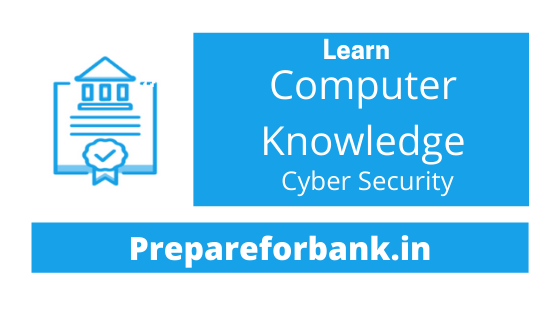Computers Knowledge is gaining importance in the Bank Exams of IBPS or SBI and Cyber Security is one of the key components. It’s very essential to know the basics of the Internet and related information so that candidates can answer correctly in exams.
Also learn about the History of Computers, Computer Hardware, Operating Systems, and Computer Network.

Study of Cyber Security
What is Cyber Security?
Cyber security is referred to us as the protection of data stored either on a personal computer, laptop, Server, Mobile, or anywhere in digital format. Data needs to be protected from unauthorized access or any attack. Cyber security may also be Known as data security.
What are Cyber Security Threats?
There are enormous threats to data security, these threats can be broadly classified into manual and automatic. A manual threat is any attempt is made to steal data or to cause harm. These are often known as Cyber Attacks.
The automatic threat is by hosting or deploying any malicious application on the host machine or server to cause harm. These applications don’t require manual interaction once it’s activated.
Malware Threats
Modern Malware has two main functions: (1) to make money and (2) to steal data. It can be categorised broadly into 4 groups:
1. Virus
A virus attaches itself to another piece of software and reproduces when said software runs. Viruses rely on human interaction to spread either through the sharing of infected files or through infected devices physically plug into different machines.
2. Worm
Worms are similar to viruses but with the one main difference: They can spread without any human interaction. The most dangerous worms can even breed across different networks, which is how the WannaCry ransomware of 2017 did so much damage.
3. Trojans
Trojans are harmful pieces of software that looks legitimate. These Trojans don’t open to reveal bloodthirsty. They can be used to create backdoors into computers and networks usually allowing criminals remote access to sensitive information and Systems.
4. Grayware
Gray ware is the collective term used to describe unwanted applications and files that can worsen the performance of the computer and lead to security risks. Unwanted browser extensions, search bars, adware, and spyware all fall into this group.
Online Threats
Ransomware and spyware are two of the most concerning online threats currently affecting both business and individuals.
1. Ransomware
Ransomware has been the most destructive and prolific form of Malware spread over the last five years. Previously only used for specialist criminals, it can now be brought online and distributed freely with a percentage of earning going to the variant’s creator.
Ransomware is a worm-like virus that restricts access to computers by encrypting files or locking down computer systems. Once a device has been impacted, ransom messages demand you a pay fee to remove the resulting restrictions. There is no guarantee that paying the ransom will overcome the infection.
2. Spyware
Spyware as its name suggests is designed to spy on people. It’s used to track online activity, collect keystroke harvest data such as account information login or financial data, and many more.
Spyware often has additional capabilities such as opening backdoors, modifying security settings, and interfering with network connections. Its normally distributed as Trojans.
Cyber Attacks
Most common ways of cyber attacks that are also use to cause potential damage to loss of data and information.
1. SQL Injection
SQL injection is a common issue with database-driven websites, where database is directly updated through URLs. SQL queries are inserted in Request to Servers and that possibly results in revealing data or modifying data.
2. Man in the Middle
Man in the Middle is again a common way to exploit data of users. The most common example is when we connect to any WiFi which is not secure and the person who’s providing this WiFi can have access to all the data transmitted.
3. Denial of Service
Denial of Service is a way to interrupter server or bombard server with huge number of fake response that it goes out of memory or unable to serve any new request. This can be deliberate attack to specific server or service.

